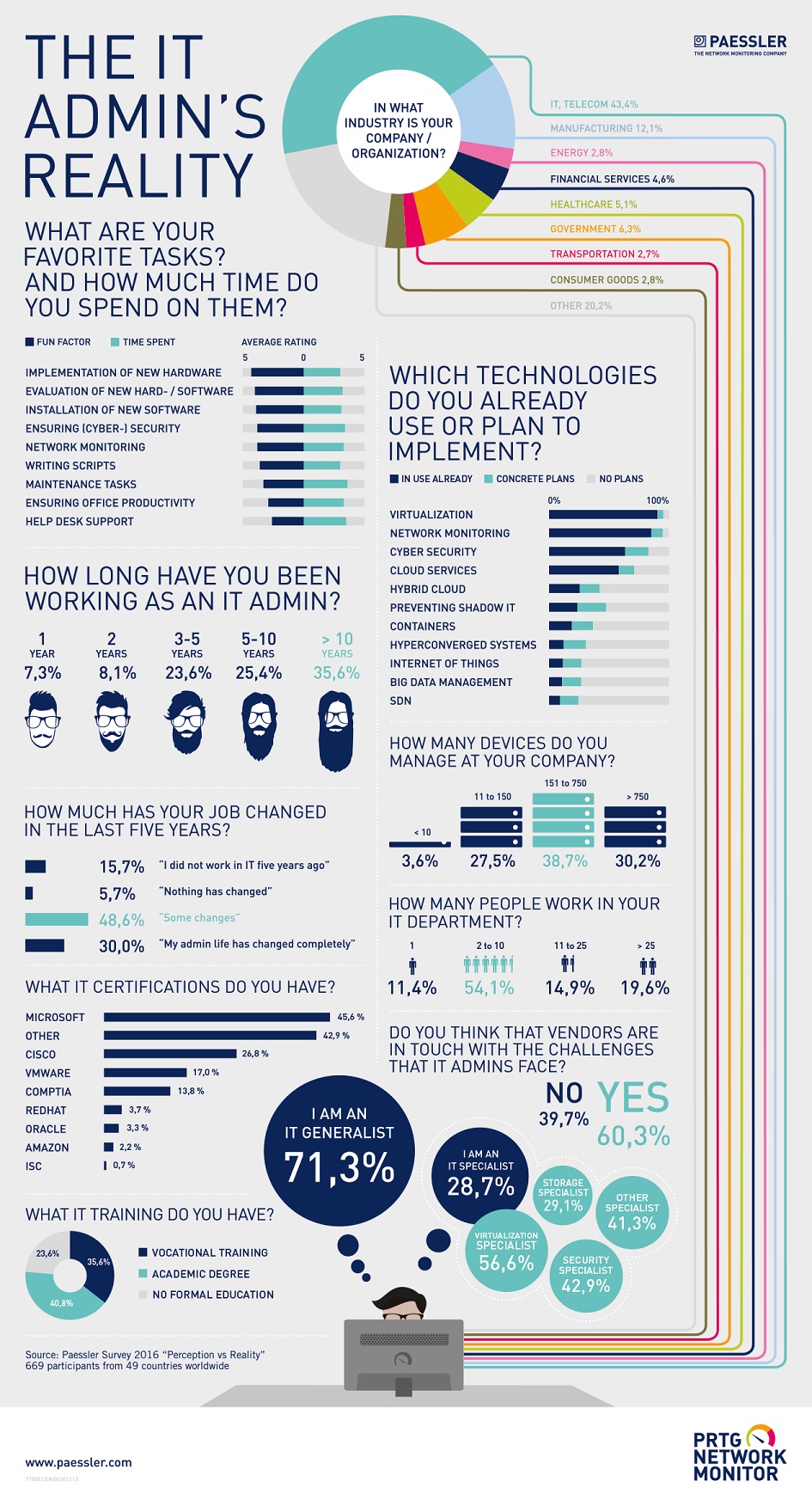In Fall 2016, Paessler AG surveyed 650 system administrators from 49 countries to get a "state of the SysAdmin" and find out how their jobs are changing, how they spend their time, and what their priorities are. The survey responses led to some interesting findings – namely, that when it comes to today's SysAdmins, things are not as they seem. Here are some of the key findings that illustrate the gap between perception and reality.
Winds of Change
The survey results show us that the role of the SysAdmin is undergoing great change. In fact, 30 percent of respondents indicated that their career has changed completely in the past five years. Also, nearly half of the respondents, 48.6 percent, indicated that their job has undergone "some change" in a five-year period. Only 5.7 percent of respondents thought that their job was the same as it was five years ago. Looking at this high level of change, I wonder if the trend will continue and how different things will become for the SysAdmin over the next five years.
Time – Not as it Seems
Other results show us that there is a significant gap between how SysAdmins are spending their time and how they prefer to be spending their time. According to the responses, SysAdmins are spending the majority of their time on internal support, maintenance tasks, and ensuring office productivity. However, what they would prefer to be spending time on is a much different list, including implementing new hardware, evaluating new products and solutions, and focusing on cybersecurity and firewalls. Clearly, they are spending most of their time on tactical, reactive tasks while they would rather be spending more time on strategic, forward-looking projects.
Also, we asked what technology services they are using or are actively planning to implement. Among the top responses were virtualization, cloud, cybersecurity and network monitoring. And, while the following topics may be widely covered in the media, few of the respondents reported plans for projects with IoT, Big Data management or Software Defined Networking (SDN).
Describe Yourself
One thing that may reflect the changes in the time spent on their day-to-day job is their titles and how they describe themselves. Among the respondents, the majority identified themselves as generalists, while only 28.7 percent described themselves as IT specialists.
Certifications and Academic Background
The survey results showed that Microsoft certifications are most popular (45.6 percent of respondents) followed by Cisco (26.8 percent), VMware (17 percent) and CompTIA (13.8) percent. For education, 40.8 percent of those surveyed had an academic degree, compared with 35.6 percent with vocational training and 23.6 percent who learned on the job.
In all, the SysAdmin that we think we know today might actually be quite different than those walking the halls at our customers or in our own companies. In fact, one more figure could reflect a gap in perception – 39.7 percent of respondents indicated that they did not believe that IT vendors understood the challenges that they faced. Maybe as perception catches up with the reality of today's SysAdmins, vendor understanding will improve as well as an overall, industry-wide understanding of what being a SysAdmin is really like.
Dirk Paessler is CEO and Founder of Paessler AG.

The Latest
Broad proliferation of cloud infrastructure combined with continued support for remote workers is driving increased complexity and visibility challenges for network operations teams, according to new research conducted by Dimensional Research and sponsored by Broadcom ...
New research from ServiceNow and ThoughtLab reveals that less than 30% of banks feel their transformation efforts are meeting evolving customer digital needs. Additionally, 52% say they must revamp their strategy to counter competition from outside the sector. Adapting to these challenges isn't just about staying competitive — it's about staying in business ...
Leaders in the financial services sector are bullish on AI, with 95% of business and IT decision makers saying that AI is a top C-Suite priority, and 96% of respondents believing it provides their business a competitive advantage, according to Riverbed's Global AI and Digital Experience Survey ...
SLOs have long been a staple for DevOps teams to monitor the health of their applications and infrastructure ... Now, as digital trends have shifted, more and more teams are looking to adapt this model for the mobile environment. This, however, is not without its challenges ...
Modernizing IT infrastructure has become essential for organizations striving to remain competitive. This modernization extends beyond merely upgrading hardware or software; it involves strategically leveraging new technologies like AI and cloud computing to enhance operational efficiency, increase data accessibility, and improve the end-user experience ...
AI sure grew fast in popularity, but are AI apps any good? ... If companies are going to keep integrating AI applications into their tech stack at the rate they are, then they need to be aware of AI's limitations. More importantly, they need to evolve their testing regiment ...
If you were lucky, you found out about the massive CrowdStrike/Microsoft outage last July by reading about it over coffee. Those less fortunate were awoken hours earlier by frantic calls from work ... Whether you were directly affected or not, there's an important lesson: all organizations should be conducting in-depth reviews of testing and change management ...
In MEAN TIME TO INSIGHT Episode 11, Shamus McGillicuddy, VP of Research, Network Infrastructure and Operations, at EMA discusses Secure Access Service Edge (SASE) ...
On average, only 48% of digital initiatives enterprise-wide meet or exceed their business outcome targets according to Gartner's annual global survey of CIOs and technology executives ...
Artificial intelligence (AI) is rapidly reshaping industries around the world. From optimizing business processes to unlocking new levels of innovation, AI is a critical driver of success for modern enterprises. As a result, business leaders — from DevOps engineers to CTOs — are under pressure to incorporate AI into their workflows to stay competitive. But the question isn't whether AI should be adopted — it's how ...







